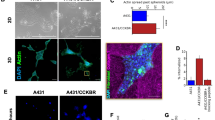Abstract
Chinese hamster cells (V79 379A) cells from a human small cell carcinoma of the lung (ME/MAR) and two xenografted human melanomas (HX117 and HX118) have been grown as multicellular spheroids in vitro. The radiation response of these four cell types has been compared when grown as spheroids (200 or 400 micron in diameter) and as single cells from disaggregated spheroids. The radiation sensitivity of the three human lines irradiated as single cells in air, is similar. In comparison, the V79 cells are more radioresistant. Only the V79 and HX118 cells show a spheroid size dependent radiation response. The radiation response of spheroids has been assayed using both cell survival and growth delay. V79, ME/MAR and HX117 cells demonstrate a good correlation between the two endpoints whereas with HX118 there appears to be greater cell kill for a given level of growth delay. This may be because HX118 is efficient in the repair of potentially lethal damage (PLD). The results support the view that extrinsic factors such as three dimensional contact, hypoxia and repair of PLD can be important and together with the intrinsic cell radiosensitivity will determine the radiation response of tumours.
Similar content being viewed by others
Rights and permissions
About this article
Cite this article
West, C., Sandhu, R. & Stratford, I. The radiation response of V79 and human tumour multicellular spheroids – cell survival and growth delay studies. Br J Cancer 50, 143–151 (1984). https://doi.org/10.1038/bjc.1984.156
Issue Date:
DOI: https://doi.org/10.1038/bjc.1984.156
- Springer Nature Limited
This article is cited by
-
Contribution of HIF-1 and drug penetrance to oxaliplatin resistance in hypoxic colorectal cancer cells
British Journal of Cancer (2009)
-
Prognostic factors in colorectal carcinoma treated by preoperative radiotherapy and immediate surgery
Diseases of the Colon & Rectum (1991)
-
Multicellular spheroids
Journal of Cancer Research and Clinical Oncology (1987)




